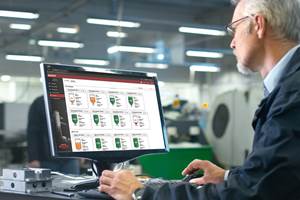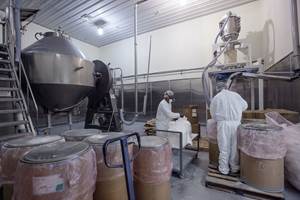Conair: Going All In on AI
Conveying with Optimizer, Conair’s new AI-based conveying technology stands to be a true game changer for plastics processors.
Share
With 12 new products to unveil at NPE 2024, there was plenty for Conair to talk about during a press conference with the plastics industry trade press leading up to the show. But the auxiliary equipment innovator was most excited to tout its first-of-its-kind conveying system that utilizes artificial intelligence to managing changing conveying conditions.
“When Conair went to NPE2018, all the buzz was about Industry 4.0,” says Sam Rajkovich, the company’s vice president of sales and marketing. “We're still installing Industry 4.0 solutions for customers, and we‘re still refining that product. It’s still a very relevant technology, but there’s this new topic that has entered the manufacturing space: artificial intelligence. Since the pandemic, we’ve spent a lot of time developing products that make use of things like sensor technology and advanced controls, so that controls essentially take over the operation of the equipment and make informed decisions about how the equipment is going to operate without operator input. That way, the equipment is always maximizing its performance to the betterment of the plant operation.”
Conveying with Optimizer
Conair calls its solution Conveying with Optimizer. It’s a patented artificial intelligence (AI)-driven feature for material handling systems using the Conair SmartFLX conveying control. Now, a SmartFLX conveying control equipped with the Optimizer package automatically detects source-to-destination conditions (vacuum, receiver distance, material bulk density and other factors) then autonomously adjusts the conveying system in real time to move material under optimal conditions.
WATCH NOW a demonstration of this breakthrough AI-driven conveying system feature.
Rajkovich continues, “We introduced Wave Conveying technology in 2016, but Conveying with Optimizer is a new spin on how customers can convey. It adds sensor and advanced controls technology to the conveying algorithm we’ve developed. The sensor technology and control technology enables the system to do things that previously were unheard of. For instance, if you develop a leak in your conveying line, the controls technology will recognize the leak and self-adjust to give you the same rate you received prior to the leak. It’ll still give you an alert, but it essentially will handle the leak as if it didn't exist and allow you to continue to make the same rate.”
Autonomous Capabilities Allow For Set It and Forget It Operation
Conair explains that autonomous capabilities of the Conveying with Optimizer feature were designed to overcome the trickiest, most labor-intensive part of conveying operations: the need to manually adjust air and material ratios (using manual air valves) from source to destination. In practical terms, that means operators must constantly change settings on distribution boxes, pickup boxes or gaylord wands to move material amid constantly changing system conditions.
When systems are properly tuned and when operators guesstimate right, material usually moves predictably. But an incorrect manual adjustment or any number of other changes — conveying distance, material bulk density/regrind ratio, relocated equipment or even a minor vacuum leak caused by a hose or coupling — can spell conveying problems that result in downtime: empty receivers, clogged lines, overloaded pumps, resin losses or excessive system wear.
The AI built into Conveying with Optimizer replaces error-prone human decisions, instead making autonomous system adjustments that move material while compensating for typical conveying system faults. The Optimizer package combines novel software, hardware, sensors and intelligence with the high-speed computing power of the SmartFLX control. Together, these elements sense, calculate and compensate for changing conditions far faster than a human could, while ensuring optimal air/material ratios and trouble-free conveying. And, the machine learning capability of the Optimizer feature enables it to continually refine and perfect each conveying cycle over time.
So, it’s no longer necessary for a processor to pay an operator to walk to the material distribution box, make a feed-tube adjustment, and then walk to the conveying control to issue a command. Now, the operator simply enters the command — locally on the SmartFLX control or remotely via Conair SmartServices on a connected device — and leaves the Conveying with Optimizer intelligence to figure it out and complete the conveying cycle.
The concept is similar to that of a self-driving car. All you have to do is select your destination and the Conveying with Optimizer intelligence takes care of the rest.
“The concept is similar to that of a self-driving car,” explains A.J. Zambanini, Conair’s director of new product development. “All you have to do is select your destination and the Conveying with Optimizer intelligence takes care of the rest. It calculates what’s needed to move material from A to B, starts the cycle and then further adapts system conditions when necessary. For example, if the bulk density of the material changes, the conveying line has a vacuum leak or the receiver filter is getting clogged. Optimizer will adapt conditions to ensure that the material gets through at the optimum speed.
“This approach is much different from a typical conveying system, where conveying conditions are preset, based on equipment, materials and distances. If there’s a change to the conditions, or there’s a problem or fault in one of those elements, the conveying cycle can become inconsistent, clog or fail. Then, you have to adjust the system manually, because, when it falls out of balance, it can’t compensate on its own.”
The only prerequisite for Conveying with Optimizer is a conveying system equipped with a SmartFLX control. The Optimizer package may be ordered with a SmartFLX control from the factory or installed to an existing SmartFLX control in the field. Optimizer hardware, which is available in line sizes from 1.5 to 4 inches OD, is installed at material pickup points, while Optimizer software upgrade is loaded into the SmartFLX control.
Related Content
New Pump Rewrites Conveying Rules
NPE2024: Smart Pump technology brings more flexibility and finesse to resin conveying.
Read MoreSingle View of Bin & Silo Material Levels in Multiple Locations
Got a bin in Buffalo and a silo in San José? BinMaster’s latest addition to its cloud inventory software lets you see all your resin inventory anywhere in one view.
Read MoreCut Loading Time Through Direct Charge Blending
Direct charge blender loading, a vacuum-powered automation process, can dramatically improve loading time and reduce material costs. In this article, we address ten common questions to help you determine if the systems are right for your facility.
Read MoreTechnology Aims to Smarten Up Resin Conveying
At NPE2024, Novatec moves to rewrite the rules for material conveying with patent-pending smart-pump technology.
Read MoreRead Next
Making the Circular Economy a Reality
Driven by brand owner demands and new worldwide legislation, the entire supply chain is working toward the shift to circularity, with some evidence the circular economy has already begun.
Read MoreSee Recyclers Close the Loop on Trade Show Production Scrap at NPE2024
A collaboration between show organizer PLASTICS, recycler CPR and size reduction experts WEIMA and Conair recovered and recycled all production scrap at NPE2024.
Read More

















